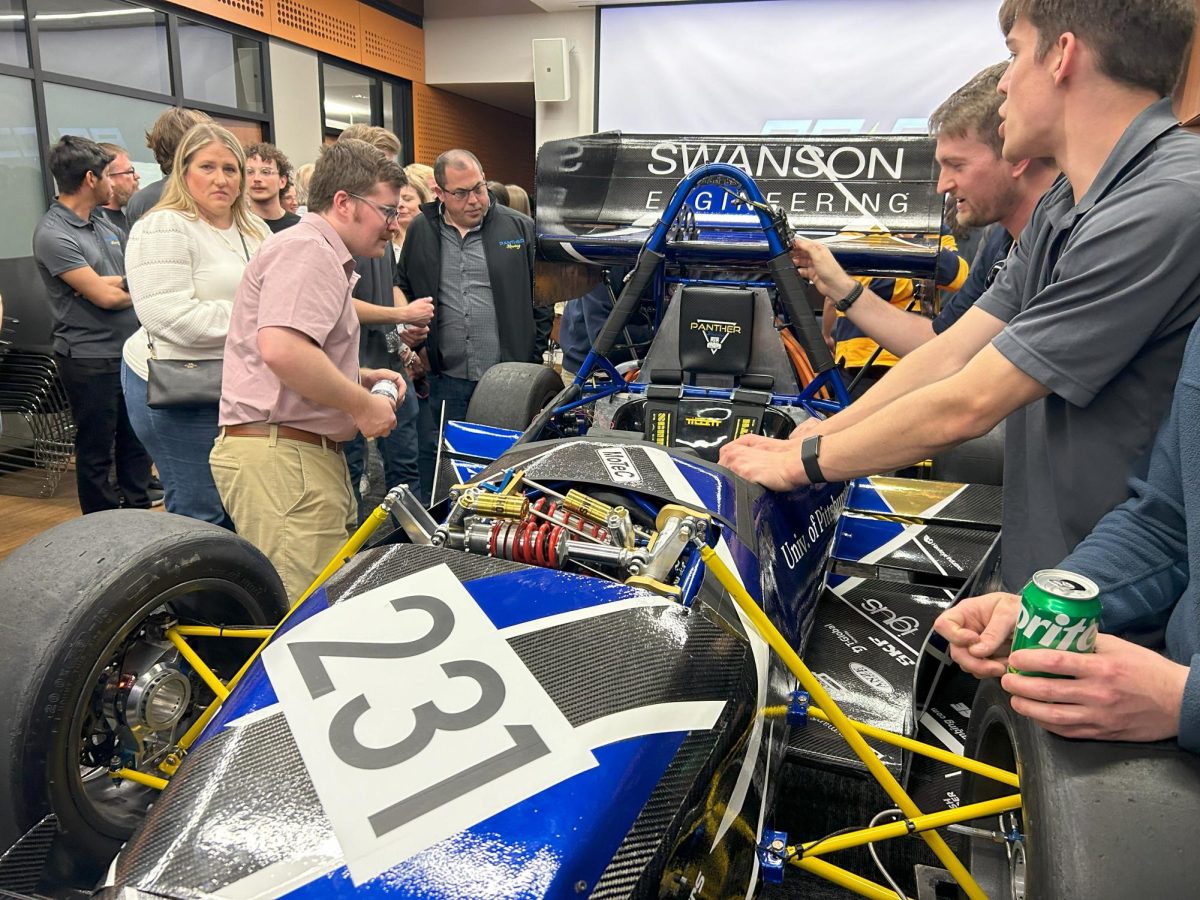A group of Pitt students on the Panther Racing Team built an electric car from scratch to compete in a Formula Society of Automotive Engineers Competition, unveiling it at an event in Benedum Hall on April 13.
The Panther Racing team competes against 120 schools every year in an SAE competition, where students are in charge of building a small formula-style race car. Pitt’s team is headed by Executive Director Luc Chadam.
“A lot of it is the judging of your project management, your engineering practices, your project designs and the actual design of your system,” Chadam, a junior mechanical engineering major, said.
During the competition, students have to drive the car and prove they built the vehicle correctly.
“Every single thing on the car is entirely designed, built and manufactured by undergraduate students on our team. You’ve got to prove that it works well and works safely,” Chadam said.
For the past 35 years, the club made gas-powered cars, but Chadam said they turned to electric because they wanted a new challenge and design.
“I think we started research and design about two years ago. We were able to select a lot of our major components before this year and make some purchases in the past couple of years,” Chadam said.
With a six-figure budget, junior supply chain major Kat Bollinger helps manage the club’s finances.
“Since it’s the first year of making an electric vehicle, we know things are going to break, mistakes are going to be made and an electric car in general is just even more expensive,” Bollinger said. “So factoring in that and trying to make sure that we can afford everything we need was important to make sure we can make the best-performing car we can.”
As a business student, Bollinger said Panther Racing provides the opportunity to take what she learns in the classroom and apply it to real life.
“I know the engineers feel the same way,” Bollinger said.
With the club consisting of 62% first-year students, Chadam said a majority of the work is knowledge transfer. Juniors and seniors often learn how to make cars in the upper-level classes and are able to pass that information on to underclassmen.
“We teach each other everything. I don’t expect whoever joins this team to know anything about race cars. It’s more hands-on work. You’ve got to practice and understand,” Chadam said. “As a freshman, sophomore who’s only taken basic introductory classes, you can still learn everything there is to know about designing a break system, things like that.”
After spending the past year building the car, the group unveiled PR-36 unveiled at the Rollout event. Before PR-36’s reveal at the event, moderator Ananya Narayanan, a junior business information systems and human resources management major, asked other Panther Racing team leads questions about the club and the process of making the car.
“When I joined Panther Racing, I was an industrial engineer,” junior mechanical engineering major Helena Ciavarelli said. “I very quickly decided to switch to mechanical engineering. I found that Panther Racing gave me the confidence to know I am capable of engineering and as a woman, that’s not an easy decision to make.”
When Ciavarelli first joined Panther Racing, she said there were only five women on the team, growing to 11 this year.
“We’re experiencing some exponential growth, which is awesome. Panther Racing gives me a sense of community. In my classes, I don’t meet a lot of women, especially in mechanical engineering, so it’s given me people to lean on in times of need and a really great community of friends,” Ciavarelli said.
Ciavarelli is the lead of the group’s Cooling Subteam, which makes a closed-loop cooling system to make the car’s thermal system. This system monitors the temperature of the car’s unit, such as the monitor and batteries.
“I remember last year when we were testing, I had the great honor of presenting the drivetrain,” Ciavarelli said. “Unfortunately, there were some issues with the drivetrain, and we had to make some pretty tough decisions.”
With the time constraints, Ciavarelli said she had to make the decision of swapping out a part or leaving it and hoping it wouldn’t break.
“I asked around to some of the more senior members, and we came to the decision that we should replace the part,” Ciavarelli said. “It was really a tough decision, but I learned a lot. I learned to listen to the people that have experience and ultimately, it was a great experience and we learned problem-solving.”
While building the car this year, junior mechanical engineer major Eddie Disy said the team struggled with building the body, known as the chassis, of the car.
“We really struggle with warping because there’s a lot of heat that goes into it and a lot of thermal stresses. They’re not always in the same spot as they are at the end,” Disy said. “It’s trial and error but also making sure the decisions we make are engineering decisions. We don’t want to make a decision because it’s the easiest, or the fastest, or the cheapest. We have to evaluate it from a racecar perspective.”
Chadam said building an electric car came with challenges, but the team is still looking forward to competing.
“We’ve been to competition every single year since 1992. We’re not looking to be the team that doesn’t go to competition for the first time since 1992,” Chadam said.



